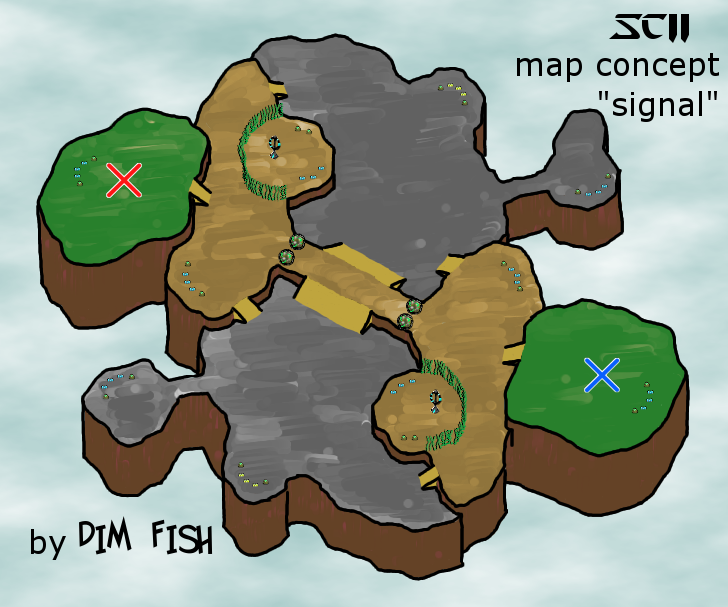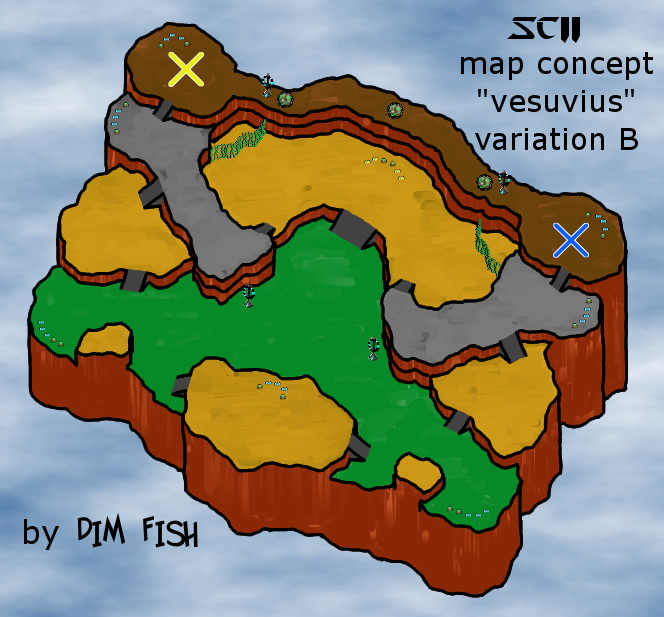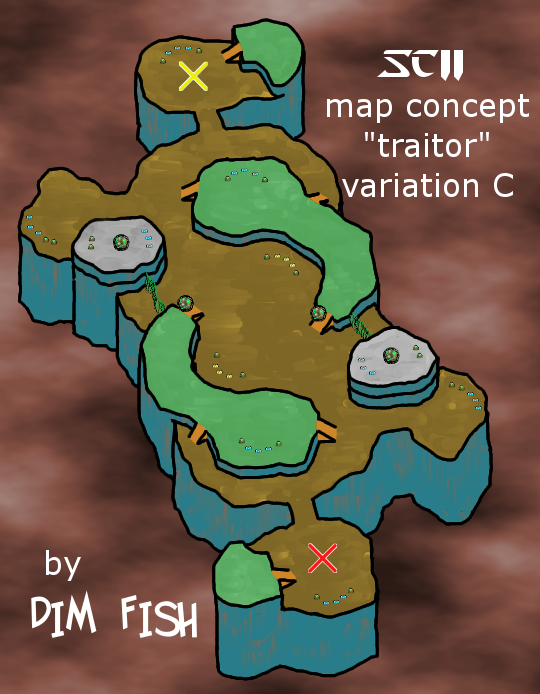
Starcraft II Melee Map ConceptsJump to...
Below are sketches of map concepts I'd like to develop for Starcraft II when the editor becomes available. Note that these are concepts, so the sketches are not necessarily to scale and the mineral icons do not show exactly how many patches are at an expansion, although it looks like 8 patches per expansion is nice for drag-select-counting workers to get the exact mining saturation you want. I did a comparison of the number of regular and high-yield resource areas in my concepts to the current versions of Blizzard maps. Thanks to Demonthese, Drews, Wjenista, Mccain, Morlar, Rah, Mardukdeathbane, Jettset, Khaile, Darkalaskan, Guardianangels, Pinycone1234, Crazy_dave, Lombego, Starshaped, 2scoops, Teardownjungles, Quintem, Dth88, and Sasori21 for their feedback and suggestions in this battle.net forum thread, the follow up thread, or Khaile's thread gathering up of the Starcraft II map designs. Legend
SignalSignal offers player a dual natural situation, though defending them clearly takes more work. A gutsy player might ignore statically defending his main ramp and put everything on the plateau with naturals, banking on not letting units slip through. If you're facing cliff-walkers like early reapers or later colossi, you might choose the natural with the watchtower so you can react to their approach. Instead of choosing either of the naturals as a first expansion, players can extend to the regular expansion with the tightest choke point or the high-yield expansion for a mineral gain. The extra minerals might be well-spent on a planetary fortress, warping-in zealots, or spine crawlers to defend the expansion first, then on combat units. There is an argument for any expansion on the map as a first expansion, so players should scout thoroughly. The shortest path between the mains descends to the lowest altitude twice until players destroy the rocks on the center walkway. A player probably wants to keep the rocks closer to her own base and destroy the other set, breaking the opponent's natural plateau wide open. 
VesuviusVesuvius is a 1v1 map with a ticking time bomb--the very short path between the main bases is blocked by three destructible rocks. In the early game players can safely concentrate on descending into the lower areas of the map with the distance between mains functioning much like other 1v1 maps. Once a player manages to clear the short path though, the mains can become the front lines. The cliffs on this map intentionally balance 2-level and 1-level elevation changes. This way cliff-walkers have advantages and specific restrictions; cliff-walkers or Zerg through a nydus worm are effective for breaking into the natural expansion, but cliff-walkers cannot cut corners on the short path between mains. Note that one set of watchtowers allows any race to monitor the short path from the start. The other set of watchtowers helps a player peek up two levels when trying to move against the opponent's natural. 
New DenverThis is a 2v2 map that puts teammates into slightly asymmetric situations. The north teammate's main ramp is wider and more forward so it is the easier for opponents to scout or attack. The south teammate's main has a longer exposed "walkable" cliff and is closer to the opponents by air. Teammates share a common area for natural expansion and staging, but the slightly different roles add a layer to match-ups. There are three lanes connecting the team's staging areas. The top lane has an interesting high ground and watchtower arrangement for controlling access to two regular expansions. The middle lane is the shortest path between teams and features exposed high-yield expansions. The bottom lane has one regular expansion and no elevation changes. 
TraitorWhat sets this map apart from other 1v1 maps is that its sense of space is different. Many 1v1 maps have a main base leading to a tight natural, then the map opens into a wider array of expansions and space in the center. Traitor has a wide space near the main with expansions and different climbable and non-climbable elevations, but a narrow center. This means players that push into the center have a lot of control. Either the high-ground expansion or low-ground one a little further from the main can serve as a first expansion, but neither of them is a really a natural. Cliff-walkers do have some advantage getting onto the high-ground expansion choice, but they do not pop right up into the mineral line, so it's not a terrifying proposition to expand there. Each of the two land-locked, 2 elevation level island expansion serve several purposes, 1) in the early game it is an "unclimbable" barrier that protects the low-ground expansion behind it 2) it has the advantages of an island expansion requiring an opponent to tech up to units that can attack it 3) it is a beastly high-ground position for map control. 
NoxiousNoxious is a 2v2 map with a balance of agressive and defensive options. Each teammate has a very different natural, and exactly where players choose to set up defenses depends on their aggressiveness. For instance, both players could concentrate early on the lowest elevation just down their wide ramp, which is wide choke--but if that position holds then it blocks all ground units including cliff-walkers from getting into the mains, naturals, or the high-yield expansion on the front porch. From the open center there are some expanion opportunities on the sides, one of which is almost a citadel of an expansion. The watchtowers allow a player to quickly scout the nearby natural, the lowest-elevation expansion, and get sight on any defenses on the lower step of the citadel expansion. Players can use the lowered area behind the main bases or the LoS blockers inside the main to hide units or techs. Similarly, these areas could be used as staging areas to infiltrate the opposing team's main. 
Resource Comparison With Blizzard MapsThis comparison ranks the maps by available resource areas per player where high-yield expansions are worth roughly 1.4x more than a normal expansion, the "combined" columns use this ratio to combine "regular" and "high-yield" columns.
Back to the Main Page. |
|||||||||||||||||||||||||||||||||||||||||||||||||||||||||||||||||||||||||||||||||||||||||||||||||||||||||||||||||||||||||||||||||||||||||||||||||